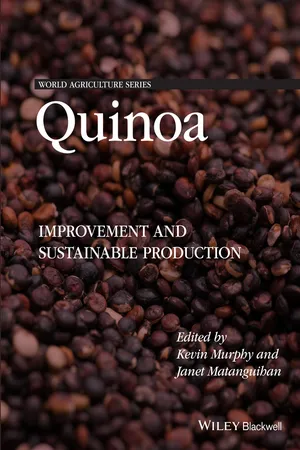Chapter 1
Quinoa: An Incan Crop to Face Global Changes in Agriculture
Juan Antonio González1, Sayed S. S. Eisa2, Sayed A. E. S. Hussin2 and Fernando Eduardo Prado3
1Instituto de Ecologia – Area de Botánica, Fundación Miguel Lillo,Tucumán, Argentina
2Agricultural Botany Department, Faculty of Agriculture, Ain Shams University (ASU), Cairo, Egypt
3Facultad de Ciencias Naturales e IML, Fisiología Vegetal, Miguel Lillo 205, 4000, Tucumán,, Argentina
INTRODUCTION
Environmental changes have always occurred in the past but in the last decades these have escalated to critical levels, presenting environmental risk to people, especially in terms of food supply, as it affects crop yield, production, and quality. Rapid population growth leads to increase in demand for land and thus to accelerated degradation and destruction of the environment (Alexandratos 2005; IPCC 2007). Probably the most important change driven by human activity is the increasing accumulation of greenhouse gases such as carbon dioxide (CO2), among others (Wallington et al. 2004; Montzka et al. 2011). Greenhouse gases can absorb and emit infrared radiation, and thus a global earth warming occurs, otherwise known as the greenhouse effect. Many scientists agree that even a small increase in the global temperature would lead to significant climate and weather changes, affecting cloud cover, precipitation, wind patterns, the frequency and severity of storms, and the duration of seasons (Solomon et al. 2009). This scenario will lead to scarce natural resources and the reduction of food production.
The net consequences of global warming on crop physiology and yield are not yet fully understood, but there are some evidences indicating that decrease in yield may be the main response (Parry et al. 2005). Another deleterious effect of global warming is the increase in diseases, especially those caused by fungi and bacteria, as a consequence of higher humidity (Chakraborty et al. 2000; Hunter 2001). As most crops worldwide are well adapted to previous weather conditions, many of these crops will become less productive and may even disappear in a future of increasing climate change. It is therefore necessary to explore plant species as alternative crops or develop new crops to grow under these changing weather patterns. In this sense, it is very important to take into account plant species that grow in different altitudinal levels or those that have thrived in mountain regions for millennia. Mountain plants, especially those adapted and cultivated in different altitudinal levels, may be very important because of the genetic richness that enabled those adaptations.
Quinoa (Chenopodium quinoa Willd.), a native grain to the Andean highlands in South America, could be an excellent alternative crop in many regions of the world. Quinoa has been grown in the Andes about 5,000–7,000 years ago and has been cultivated in different ecological zones from sea level in the northwest region of Chile to altitudes over 4,000 m above sea level (masl) in the Bolivian Altiplano (Fuentes et al. 2009). Owing to this plasticity, quinoa has been introduced to higher latitudes as a new or alternative crop, with reports indicating an acceptable adaptation of this species in the United States, Canada, and Europe (Johnson and Ward 1993; Jacobsen 1997) and recently in Morocco (Jellen et al. 2005), India (Bhargava et al. 2006, 2007), and Italy (Pulvento et al. 2010).
A BRIEF HISTORY OF QUINOA CULTIVATION
Archeological studies provide evidence on the consumption of quinoa as human food thousands of years before the first Spanish conquerors arrived in America. Uhle (1919), taking into account evidences from Ayacucho (Perú), said that quinoa domestication began almost 5,000 years bc. According to Nuñez (1974), quinoa was utilized in the north region of Chile at least 3,000 years bc. Many chronicles and archeological studies provide evidence that quinoa was used by indigenous people for centuries in Colombia, Ecuador, Perú, Bolivia, Chile, and the Argentinean northwest. During pre-Columbian times, quinoa seed served as a staple food in the Incan diet, leading the Incas to call it the “mother grain” and considered it as a gift of the sun god, “Inti.” It is believed that the Incas considered quinoa to be a sacred plant. Religious festivals including an offering of quinoa in a fountain of gold to the Inti god were held. The Inca Emperor used a special gold tool to make the first furrow of each year's quinoa planting. In Cuzco, ancient Incas worshipped entombed quinoa seeds as the progenitors of the city. The first Spanish conqueror who mentioned quinoa was Pedro de Valdivia. In 1551, he wrote to Carlos I, the Spanish Emperor, about the presence of some crops in the neighboring area of Concepción, Chile and specifically mentioned “…maize, potatoes and quinuas…” (Tapia 2009). On the other hand, in the Comentarios Reales de los Incas, a book written by Inca Garcilaso de la Vega and published in 1609 in Lisbon, Portugal, Garcilaso mentioned “quinoa” as one of the first crops in the Inca Empire (de la Vega 1966). Garcilaso mentioned that there was an intent to export quinoa to Spain but the seeds were nonviable. Other authors had also mentioned the existence of quinoa in Pasto and Quito, Ecuador (Cieza de León 1560), in Collaguas, Bolivia (Ulloa Mogollón 1586), Chiloé island in Chile (Cortés Hogea 1558), and in the Argentinean Northwest and Cordoba province, Argentina (de Sotelo 1583). During the Spanish conquest of South America in the sixteenth century, quinoa was scorned as a “food for Indians” and the conquerors destroyed fields of quinoa, actively suppressing its “non-Christian” production and consumption. The Incan peoples under the yoke of Spanish oppression were forbidden to grow it on pain of death and were forced to grow corn instead. According to Tapia (2009), afte...
